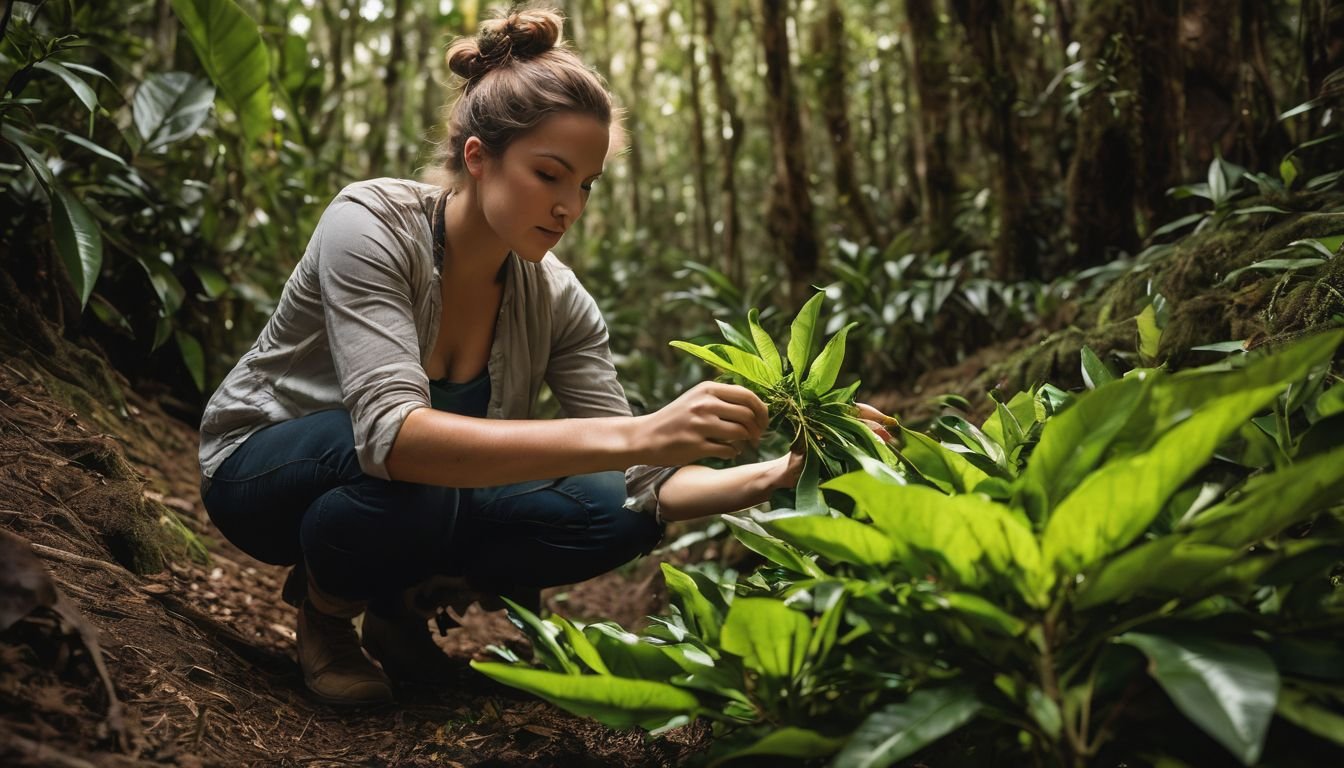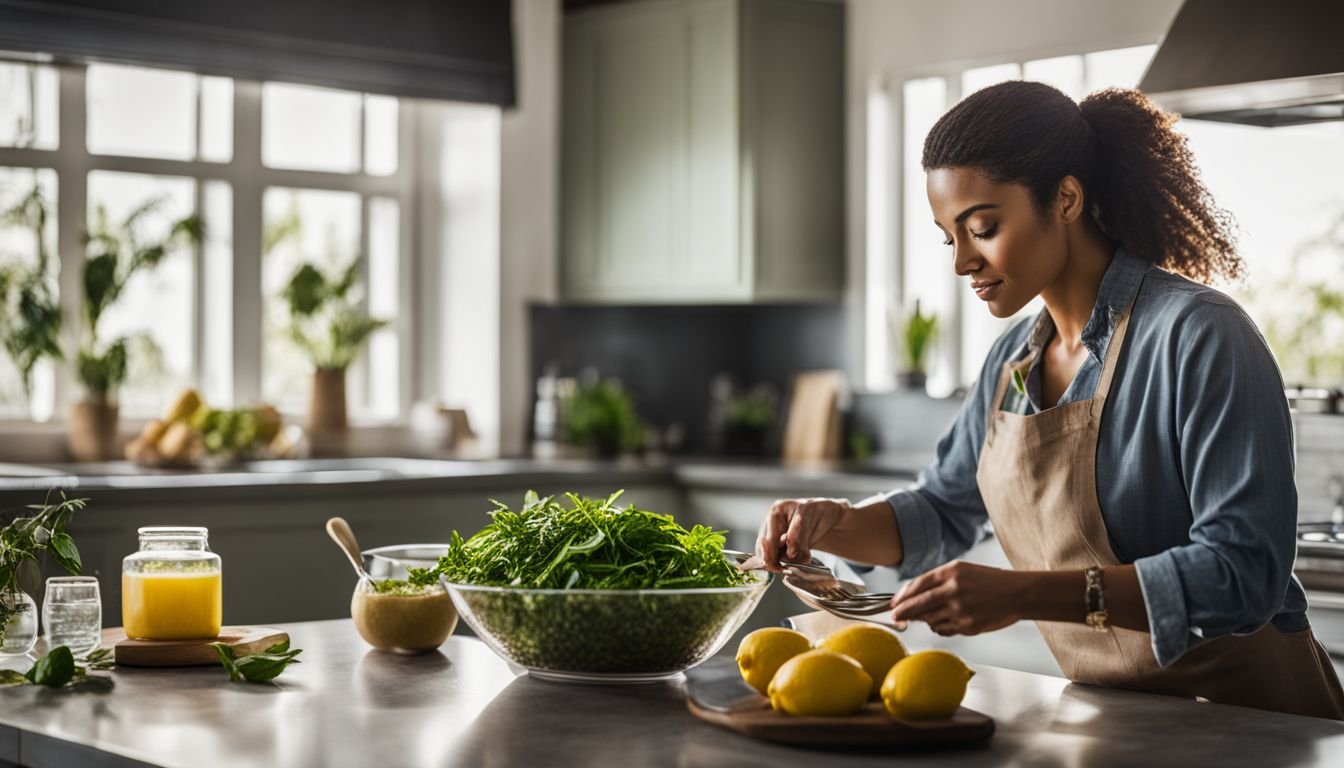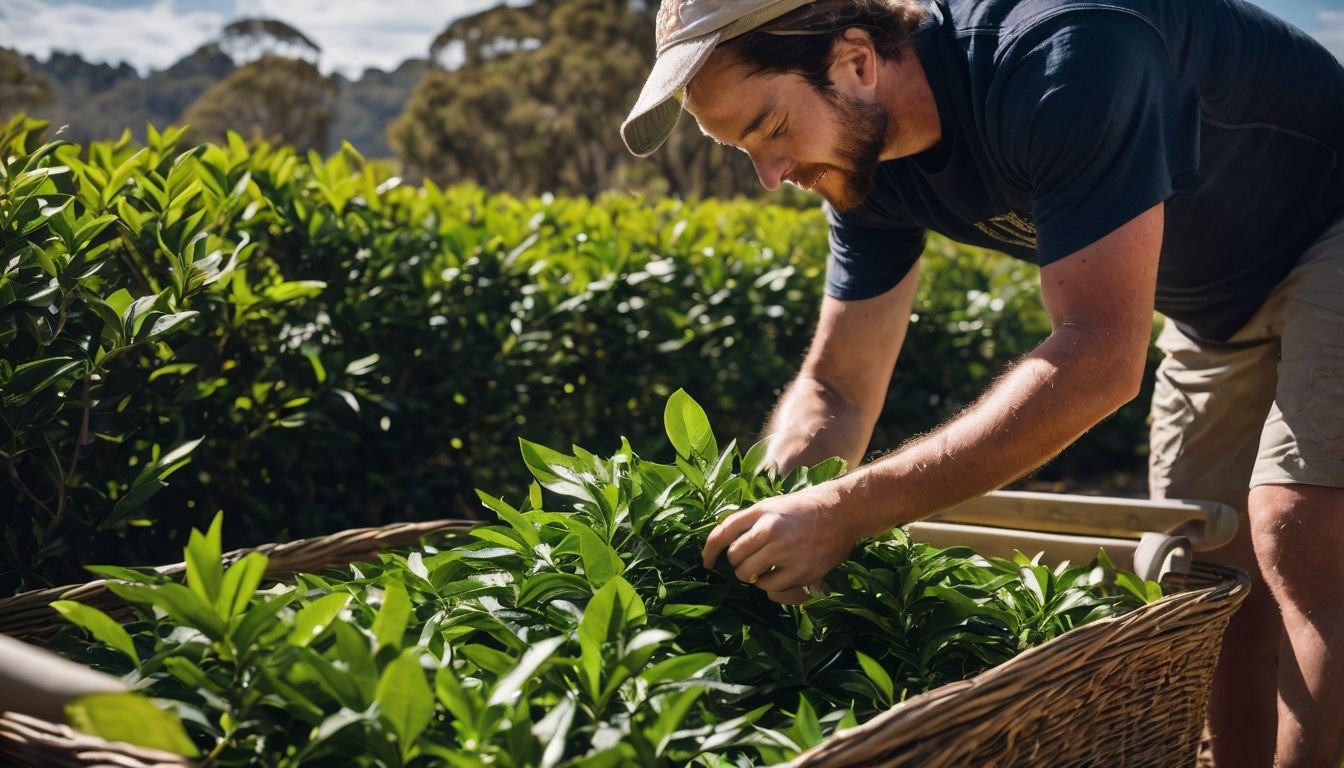Finding the right addition to your garden that provides both charm and utility can often be a challenge. Enter lemon myrtle, an Australian native with a refreshing citrus scent that’s as delightful in dishes as it is in the garden.
Our blog post will guide you through the myriad benefits of this versatile plant, from its culinary delights to its cultivation secrets. Uncover the wonders of lemon myrtle and let your senses soar!
Key Takeaways
- Lemon myrtle is a versatile Australian native plant with a strong citrus aroma and can grow up to 20 metres in the wild, but remains smaller when cultivated in gardens.
- This aromatic plant is not only used for its flavourful leaves in cooking but also has antimicrobial properties that make it valuable in hygiene and healthcare products.
- Lemon myrtle’s essential oil, derived through distillation of its leaves, contains compounds like citral which contribute to its health benefits such as antifungal and antibacterial qualities.
- With high levels of calcium, zinc, magnesium, vitamins A and E, lemon myrtle supports overall well – being while offering an array of culinary uses from teas to desserts.
- Cultivating lemon myrtle involves creating subtropical climate conditions with full sun exposure and well-enriched soil; regular pruning promotes healthy growth allowing sustainable leaf harvesting.
The Unique Characteristics of Lemon Myrtle

Lemon Myrtle, with its vibrant citrus scent, stands out in the subtropical rainforests of Australia as more than just a feast for the senses. Its ecological significance and intriguing nomenclature capture the essence of this native wonder, beckoning a closer look at what sets it apart from other flora.
Description and Ecology
Lemon myrtle flourishes in the lush subtropical rainforests of Australia, where it stands as a testament to both beauty and resilience. Known officially as Backhousia citriodora, this tree is a spectacle with its vibrant green foliage bursting with an enchanting lemon scent that earns it the title ‘queen of the lemon herbs’.
Its natural habitat provides a shaded canopy where it can soar up to 20 metres high. However, in sunny garden spots, this plant adopts a more domesticated stature ranging between 2-8 metres tall.
The ecology surrounding these trees teems with life; their leaves are not only aromatic but also serve as a hub for various wildlife. They prefer soils that mirror their native settings – well-draining yet rich enough to support their growth without constantly needing artificial boosts from organic fertiliser.
Lemon myrtle showcases remarkable adaptability by tolerating light frost once mature, making it an excellent choice for growers who face occasional cold snaps in otherwise warm climates with regular rainfall.
This characteristic underlines why many Australians prize this tree not just for its uses but also for adding lush diversity to their gardens.
Etymology
The name “lemon myrtle” showcases the plant’s most striking feature: the rich, tangy aroma reminiscent of lemons that wafts from its crushed leaves. It’s no surprise that this scent has led to nicknames such as lemon scented myrtle and sweet verbena tree, alluding to both its fragrance and visual elegance.
Revealing further layers of history, the botanical moniker Backhousia citriodora honors James Backhouse, an English botanist whose work in Australian flora was renowned in the 19th century.
Exploring its etymology takes us on a journey through sensory experiences connected by language and nature. The common names like lemon scented ironwood or lemon scented verbena capture not just a smell but also hint at various related species within vast ecosystems where these plants thrive.
These labels provide clues about how people have interacted with Lemon Myrtle over time – using sensory perceptions to define and relate to this versatile plant.
The Versatile Uses of Lemon Myrtle

Lemon Myrtle, a native botanical marvel, isn’t just a treat for the senses; its versatility extends from the kitchen to natural medicine cabinets. This fragrant Australian treasure presents an abundance of applications that intrigue eco-conscious and health-oriented individuals alike.
Culinary Uses
- Infusing lemon myrtle leaves into hot water makes an invigorating tea that showcases its vibrant taste.
- Add ground lemon myrtle to spice blends for an aromatic kick that pairs beautifully with chicken, fish, or vegetable dishes.
- Incorporate dried flakes into baking for a zesty twist in biscuits, cakes, or pastries.
- Use the encapsulated flavour essence as a secret ingredient in homemade ice creams or sorbets for a refreshing dessert option.
- Mix crushed leaves into marinades and dressings to impart a tangy note that elevates salads and grilled meats.
- Create zesty rubs by combining dried lemon myrtle spice with salt, perfect for seasoning before barbecuing.
- Experiment with infused oils where the essence of lemon myrtle adds complexity to pasta sauces or as a dipping oil for bread.
Antimicrobial Properties
Lemon myrtle shines as a natural defender against bacteria and fungi, boasting impressive antimicrobial properties. This robust plant’s essential oil is packed with compounds that combat harmful microorganisms, which makes it an ally in preserving food and bolstering pharmaceutical products.
Gardeners appreciate not only its vibrant foliage but also the protective qualities that can help keep other plants healthy.
Incorporating lemon myrtle into your home goes beyond just aesthetic appeal. Its leaves work wonders in natural cleaning solutions and personal care items, providing a chemical-free alternative to traditional products.
Even skin conditions like molluscum contagiosum have met their match with this plant’s potent extracts, while adventurers find solace in its use as an effective insect repellent—keeping mosquitoes at bay without harsh chemicals.
Essential Oil Distillation
The process of extracting essential oil from lemon myrtle is both fascinating and rewarding. Plant enthusiasts find that distilling this fragrant oil can boost their understanding of the plant’s many gifts.
- Begin with healthy, vibrant leaves of lemon myrtle to ensure a high – quality essential oil yield.
- Harvest the leaves and small twigs ideally in the morning when the aromatic compounds are most potent.
- Rinse the harvested materials gently to remove any dirt or insects without damaging the essential oils on the leaf surfaces.
- Chop or bruise the lemon myrtle leaves to release their potent oils before you start the distillation process.
- Set up your distillation equipment, ensuring all parts are clean and properly assembled for efficient operation.
- Fill the distiller with water and add your prepared lemon myrtle leaves; make sure you follow manufacturer guidelines for quantities.
- Heat the water slowly to avoid burning the plant material, which could affect oil quality and scent profile.
- Monitor temperature closely through a thermometer to keep it within optimal ranges for extracting essential oils without degrading them.
- Collect condensate from the cooling coil, which contains both water and essential oil; this mixture is known as a hydrosol.
- Separate the oil from water using a separator funnel; given its lower density, lemon myrtle oil will float on top and can be easily collected.
- Store your distilled essential oil in dark glass bottles away from light and heat to preserve its antimicrobial properties and fresh citrus scent.
The Health Benefits of Lemon Myrtle
Lemon Myrtle, with its refreshing citrus scent and nutrient-rich leaves, emerges as a powerful ally for health-conscious individuals. It offers an array of benefits that are backed by traditional use and modern science, from its antifungal properties to its role in maintaining personal wellbeing.
Nutrient Richness
Lemon myrtle dazzles with its nutrient richness, boasting high levels of calcium, zinc, and magnesium. These minerals are pivotal for strong bones, a robust immune system, and overall wellbeing.
Each leaf is packed with antioxidants like citral and lutein, which help fight off damaging free radicals in the body.
Not to be outdone by its mineral content, this plant also delivers essential vitamins such as vitamin A for eye health and vitamin E for skin protection. Its exceptional concentration of citral doesn’t just impart that vibrant lemony zing; it contributes to the antimicrobial properties that have made lemon myrtle a cherished medicinal herb among Indigenous Australians for centuries.
Antifungal and Antibacterial Properties
Lemon myrtle stands out for its impressive antifungal and antibacterial qualities. Extracts from this plant have shown great effectiveness against a range of microbial threats. Researchers have found that essential oil distilled from lemon myrtle leaves can combat pathogens responsible for infections and spoilage.
This natural defender contains compounds that ward off bacteria, making it an ally in preserving foods and creating natural cleaning products. Its potency has been tested on human skin with positive outcomes concerning toxicity and absorption, indicating potential uses in personal care items like shampoos without harsh side effects.
Lemon myrtle’s antimicrobial prowess provides plant lovers with another reason to cherish this aromatic Australian native.
Refreshing Lemon Scent
The refreshing lemon scent of lemon myrtle is a true standout feature. Its vibrant aroma is so potent that just brushing against the leaves releases a delightful citrus burst into the air, invigorating any space it occupies.
Gardeners and plant enthusiasts appreciate this attribute, making it a popular choice for those looking to infuse their surroundings with natural fragrance.
Incorporating lemon myrtle into your garden not only adds an aromatic dimension but also invites local wildlife. Birds are attracted to the rich scent, enhancing biodiversity in native gardens.
Imagine sitting in your backyard as colourful birds flit among the plants, all while a gentle breeze carries the soothing notes of citrus from your thriving lemon myrtles. This plant truly elevates outdoor spaces with its multi-sensory appeal.
Exploring the Comprehensive Benefits of Lemon Myrtle
Lemon myrtle not only thrives as a bush food but also stands out for its exceptional benefits. This hardy plant’s leaves contain potent anti-microbial properties, making it a key ingredient in hygiene and health care products.
Often harnessed for its distinctive citrus fragrance, lemon myrtle essential oil is cherished across various industries. From refreshing room sprays to soothing skin balms, it infuses everyday items with both aroma and antibacterial benefits.
Garden enthusiasts embrace lemon myrtle’s versatility; the dried flakes serve as a zesty addition to culinary creations while fresh foliage doubles up as an aromatic garnish. Its cultivation practices are straightforward: adequate pruning keeps sooty mould at bay and safeguards against common pests like myrtle rust (Uredo rangelii).
In this way, lemon myrtle provides countless advantages from garden to table, offering a touch of zest wherever used.
The Cultivation of Lemon Myrtle in Australia
Lemon myrtle thrives in the unique climatic conditions of Australia, where dedicated growers have honed their skills to produce this aromatic native plant. Understanding its optimal environment and mastering specific cultivation techniques are key to unlocking the full potential of lemon myrtle’s vibrant leaves.
Ideal Growing Conditions
Lemon Myrtle flourishes under specific conditions that are crucial for its health and productivity. Here’s how you can create an ideal environment for growing this aromatic plant successfully:
- Aim for a subtropical or warm climate, where the temperatures are mild and there is regular rainfall.
- Make sure the location provides full sun, as Lemon Myrtle loves direct sunlight to thrive.
- Prepare your soil by enriching it with organic matter; this ensures proper drainage and nutrition for the roots.
- The potting mix used should be of high quality, mimicking the plant’s natural habitat for better growth.
- Young plants sometimes need protection from strong winds until they establish themselves firmly in the ground.
- Water consistently, keeping the soil moist but not waterlogged to prevent root rot.
- Incorporate a slow – release fertiliser to provide essential nutrients over time, aiding in robust development.
- Prune strategically to promote bushiness and increase airflow, which helps prevent disease in denser foliage areas.
- Watch out for adventitious roots that might sprout; these should be handled carefully if transplanting or propagating from cuttings is desired.
- Be mindful of frost; while mature Lemon Myrtle can handle light frosts, younger plants may require protection during colder months.
Harvesting Methods
- Regular pruning helps shape lemon myrtle into a productive shrub. This practice encourages new growth which leads to more leaves that can be harvested.
- Snip leaves with sharp secateurs for a clean cut, protecting the plant from disease and unnecessary stress.
- Collect leaves on dry, sunny days when essential oils are highest, maximising the aromatic potency of your harvest.
- Dry the leaves naturally in a shaded, well – ventilated area, ensuring they retain their robust flavour and scent.
- Use dehydrators at low temperatures if quick drying is needed without compromising essential oil content.
- Separate leaves from twigs after drying; this allows for different uses such as leaf spice or oil distillation.
- Distil fresh leaves quickly after harvesting if extracting essential oil is your goal, as this yields the highest quality product.
- Rotate your harvesting areas throughout the plantation to allow plants time to recover, promoting sustainability and long-term yield.
Special Equipment for Leaf and Twig Separation
Separating leaves and twigs from the lemon myrtle harvest requires precision to maintain the integrity of this aromatic plant. Specialised equipment is essential for this delicate task, designed to gently handle the plant’s parts without crushing or damaging the flavourful leaves.
In Australia, cultivators use advanced machinery that efficiently sorts through bulk quantities, ensuring that only the highest quality foliage reaches consumers.
Garden enthusiasts curious about cultivating their own lemon myrtle should know that plants come in manageable sizes, with pots measuring 80mm high by 42mm wide—perfect for individual growers.
For those seeking more information on these processes and equipment types, there’s a dedicated customer service line to guide you through your cultivation journey. Moving forward from leaf separation methods shines a light on another aspect of lemon myrtle’s allure: its essential role in Australian native bush food.
Lemon Myrtle in Australian Native Bush Food
Lemon Myrtle holds a special place in the heart of Australian native bush food, deeply rooted in the traditional diets of Indigenous Australians. Today, its vibrant citrus flavour is being embraced by contemporary cuisine, finding its way into an array of modern Australian dishes and products.
Role in Traditional Diets
Indigenous Australians have long cherished lemon myrtle for its vibrant flavour and health properties, incorporating the leaves into their diets for centuries. This native bushfood is steeped in tradition, often brewed as a refreshing citrus tea that not only delights the senses but also offers nutritional benefits.
Lemon myrtle’s distinctive taste has secured its place as one of the most popular and well-known flavours in traditional Australian cuisine.
Culinary experts today continue to explore this herb’s potential, using it to add a zesty twist to modern dishes and beverages. Beyond just tea, chefs crush fresh leaves to season meats, desserts, and sauces with its aromatic zest.
The combination of rich cultural heritage and contemporary culinary innovation confirms lemon myrtle’s pivotal role in both past and present Australian diets.
Modern Incorporation into Food Products
Lemon myrtle’s unique zesty flavour is revolutionising the culinary world in Australia and abroad. This native bushfood has found its way into contemporary food products, delighting chefs and food enthusiasts with its citrusy punch.
- Tea infusions: Lemon myrtle enhances herbal teas with its refreshing lemon tang, offering a delightful alternative to traditional teas. Its leaves are dried and mixed with other herbs to create aromatic blends that soothe the senses.
- Gourmet marinades: The leaves of lemon myrtle impart a vibrant citrus note to marinades, elevating the taste of meats like chicken and fish. Foodies incorporate finely ground leaves into their recipes for a burst of flavour.
- Savoury sauces: Innovative chefs utilise lemon myrtle to add zest to sauces, creating new taste experiences. This ingredient offers a subtle yet distinct lemony aroma that complements both creamy and tangy sauce bases.
- Dessert delights: Artisans use lemon myrtle in desserts such as ice creams, puddings, and cakes. Its extract provides a natural sweetness that pairs wonderfully with various dessert profiles.
- Beverage boosts: Baristas and bartenders infuse lemon myrtle into cocktails and non-alcoholic drinks for an extra kick. The plant’s essence brings an Australian twist to beverages enjoyed around the globe.
Conclusion
Discover the wonders of lemon myrtle, a true gem from Australia’s lush landscapes. Embrace its vibrant citrus notes in your kitchen or bask in the soothing aroma of its essential oil.
Cultivating this remarkable plant brings a touch of Aussie nature to your garden and invites an array of birdlife. Revel in the health benefits, and let the versatility of lemon myrtle inspire new favorites on your menu and shelves.
Cherish this Australian native for all it offers – a splendid amalgamation of culture, wellness, and horticultural delight.
FAQs
1. What are the benefits of using Lemon Myrtle?
Lemon Myrtle, a plant native to Australia, is celebrated for its refreshing citrus scent and antiseptic properties. The leaves contain powerful essential oils used for flavouring foods and in natural health products.
2. Can Lemon Myrtle be grown alongside Eucalyptus Staigeriana?
Yes, both Lemon Myrtle and Eucalyptus Staigeriana thrive in similar climates in Australia; they can be cultivated together, as long as each plant’s space and soil requirements are met.
3. Is Lemon Verbena the same as Lemon Myrtle?
No, they are different plants. While both have a lemony scent used in cooking and teas, Lemon Verbena originates from South America whereas Lemon Myrtle is indigenous to Australia.
4. How do you use Lemon Myrtle at home?
Lemon Myrtle can be utilised at home in various ways: infuse it into teas or desserts for a zesty flavour or incorporate the oil into homemade cleaning agents for its antiseptic qualities.
